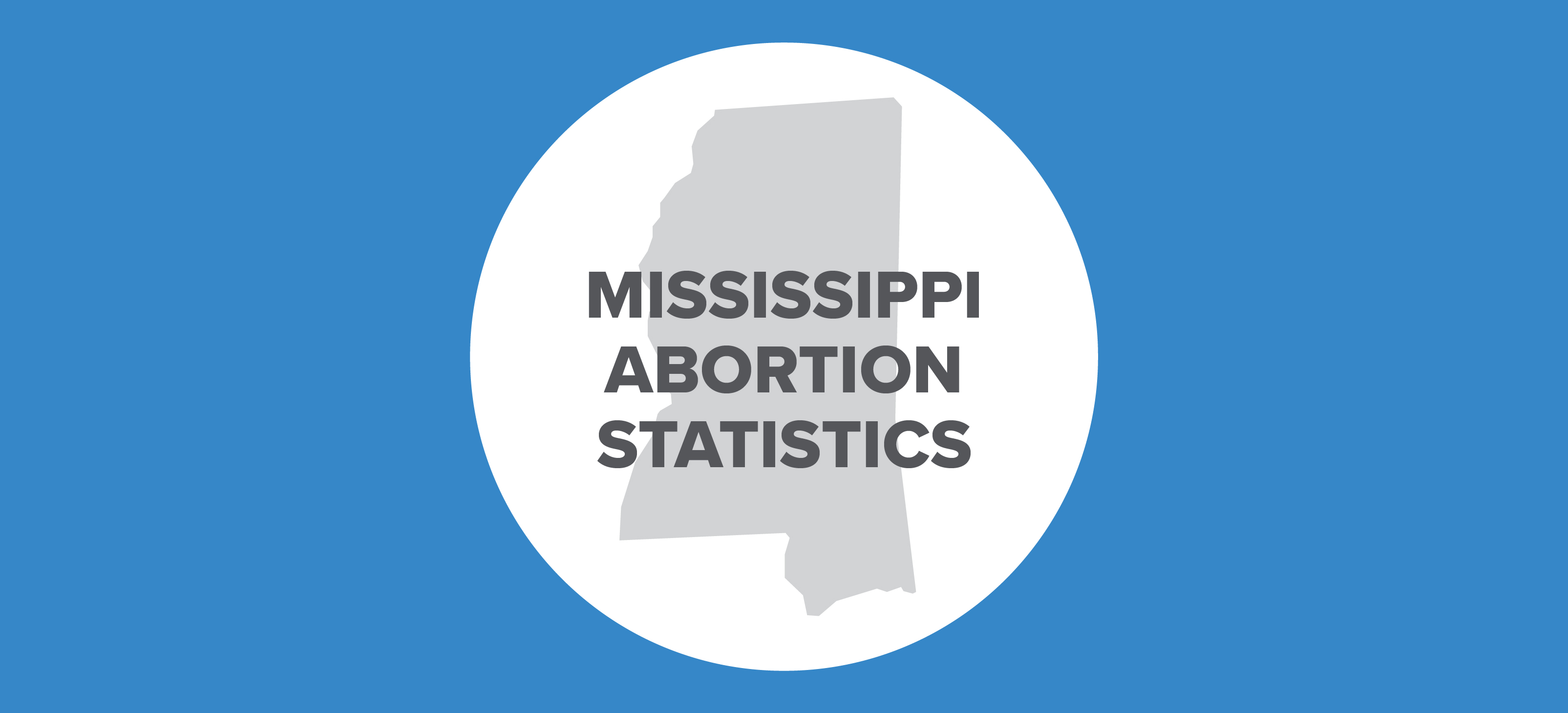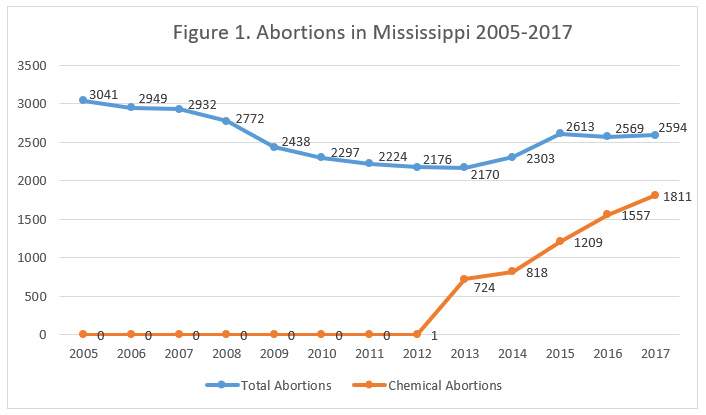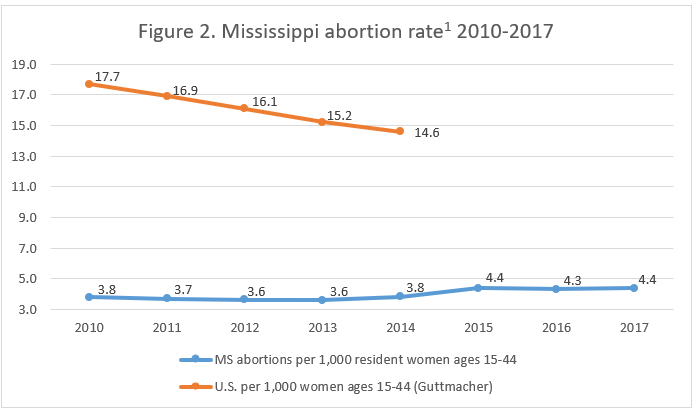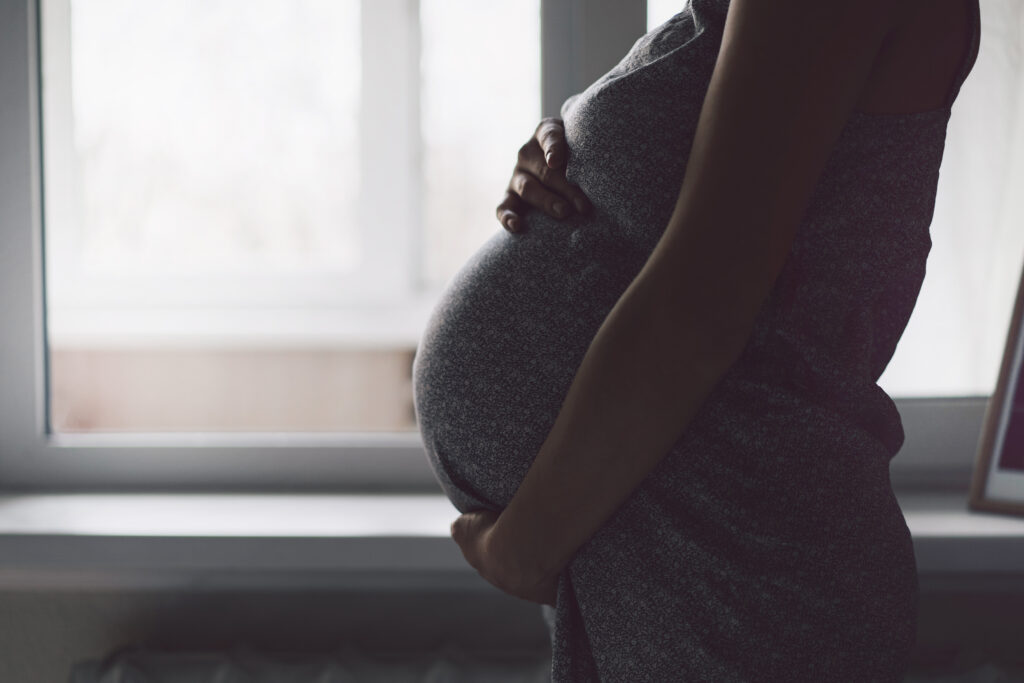Abortion Reporting: Mississippi (2017)

Mississippi’s 2017 abortion report reveals that chemical abortions are on the rise. Abortion statistics have been published online only through 2012, but the Mississippi State Department of Health made reports for 2013 through 2017 available to the Charlotte Lozier Institute (CLI) upon request.
Changes in Mississippi Abortions, 2016-2017

*Information on Mississippi’s state abortion rate and Planned Parenthood’s Mississippi market share is not publicly available.
Abortion Totals and Trends
There were 2,594 abortions performed in Mississippi in 2017, an increase of not quite one percent from the 2,569 abortions reported in 2016. Since 1991, when a record 8,184 abortions were reported in Mississippi, abortions have fallen by over 68 percent. At the same time, chemical abortions have increased dramatically. Chemical abortions rose by 16 percent from 1,557 in 2016 to 1,811 in 2017. Since 2013, when chemical abortions began to be reported frequently in Mississippi, they have increased by 150 percent. Chemical abortions made up 70 percent of the total number of abortions performed in Mississippi in 2017. Mississippi does not report the state abortion rate, but the Charlotte Lozier Institute estimates that the 2017 rate was 4.4 abortions per 1,000 resident women between the ages of 15 to 44, up from 4.3 the previous year.
State Report Summary
In 2017, the vast majority of Mississippi abortions (95 percent) were performed on Mississippi residents. Four percent were performed on women from states bordering Mississippi and less than half a percent on women from other states. With just one abortion clinic operating in Mississippi, many women leave the state to obtain abortions. In addition to the tables produced for Mississippi’s upcoming 2017 vital statistics report, Mississippi publishes abortion statistics for Mississippi residents in an online database, the Mississippi Statistically Automated Health Resources System (MSTAHRS). MSTAHRS does not include data on abortions performed on nonresidents. In 2017, 4,289 abortions were performed on Mississippi residents, both in Mississippi and in other states, although MSTAHRS does not specify where these abortions occurred. However, comparing the 4,289 total resident abortions reported by MSTAHRS with the 2,467 in-state resident abortions reported by the vital statistics tables indicates that in 2017, approximately 1,800 Mississippi women got abortions in different states.
Eleven percent of the abortions reported in Mississippi were performed on women age 19 or younger. Sixty-two percent were performed on women in their twenties, a quarter on women in their thirties, and not quite two percent on women age 40 or older. A large majority of the abortions performed in Mississippi were on black women – more than 78 percent. Eighteen percent were on white women and just four percent on women of a different race. CLI estimates that in 2017, Mississippi’s abortion rate among white women was 1.4 abortions per 1,000 women of childbearing age, less than a fifth of the abortion rate among black women (7.9 abortions per 1,000 women).
Eight percent of the abortions were performed on married women, 88 percent on unmarried women, and four percent on women whose marital status was unknown. Eight percent of the women had not graduated from high school, while 27 percent had a high school diploma. Forty-two percent had completed some college but did not have a degree. Fourteen percent had obtained an associate’s or bachelor’s degree, and five percent had a master’s degree or doctorate. Level of education was unknown for four percent of the women who got abortions.
Thirty-one percent of the abortions were performed on women who had no living children. Twenty-nine percent had one living child, and 40 percent had two or more. In contrast, two-thirds of the women had never had an abortion before. Twenty-two percent had one previous abortion, and 11 percent had more than one. The majority of abortions occurred in the first trimester. Sixty-five percent were performed before nine weeks of gestation, 17 percent between nine and 10 weeks, and eight percent between 11 and 12 weeks. Nine percent were performed between 13 and 16 weeks of gestation. Five abortions were performed between 17 and 20 weeks, and two abortions occurred at 21 weeks of gestation or later. Mississippi prohibits abortions after 20 weeks of gestation, when unborn babies can feel pain, unless the mother’s life or a major bodily function is at risk or the baby has a severe abnormality. Mississippi has passed legislation that would prohibit abortion once a heartbeat is detected, but the law is being challenged in court and is not yet in effect. In 2017, 70 percent of the abortions reported in Mississippi were chemical abortions. Thirty percent were performed via suction curettage.
Chemical Abortion in Mississippi
Zero chemical abortions were reported in Mississippi between 2002 and 2012 before jumping suddenly between 2012 and 2013. Mississippi’s single abortion center, Jackson Women’s Health Organization (JWHO), advertised chemical abortions prior to 2012. However, a lawsuit filed in 2012 by JWHO’s former medical director, who worked for JWHO from 2002 to 2010, describes a disagreement between the medical director and the owner of JWHO over the chemical abortion protocols used at the center. The medical director felt that the owner’s decision to ignore the FDA protocol was unsafe and refused to administer Mifeprex using the owner’s method. The medical director alleged that JWHO’s owner brought other doctors from out of state to dispense Mifeprex. It is unclear how many, if any, chemical abortions were provided by JWHO prior to 2012. It is possible that some chemical abortions that were performed by itinerant, out-of-state physicians may have gone unreported. The Mississippi Department of Health suggested in an email to CLI that the latest version of Mississippi’s abortion reporting form, issued in 2012, may have brought more clarity to providers and allowed for more accurate reporting. In a Politico article that was published in 2012, the owner of JWHO stated that the center performed more than 2,000 abortions annually. This corresponds to the 2,179 abortions that were reported by the Mississippi Department of Health and suggests that in 2012 at least, JWHO’s private internal count of abortions did not differ drastically from the numbers reported to the Department of Health.
State Ranking
In a CLI study that ranked the 50 states, New York City, and Washington, D.C. on the quality of their abortion reporting, Mississippi fell in the middle, tying for 25th best. To improve its reporting, Mississippi could make abortion data publicly available online more quickly. Mississippi could also work to enforce its reporting laws. Mississippi requires doctors to submit reports to the health department whenever they encounter complications resulting from abortion. However, Mississippi received no complication reports in 2014, 2015, 2016, or 2017, suggesting that complications are going unreported. With chemical abortions – which studies suggest result in significant complications – continuing to increase in Mississippi, accurate reporting of abortion complications is particularly necessary.


- Mississippi does not report the state abortion rate. Rates were calculated by the Charlotte Lozier Institute using population estimates from the United States Census Bureau. The rates were calculated using the following formula: (Abortions performed in Mississippi ÷ number of resident women ages 15-44) x 1,000.

























